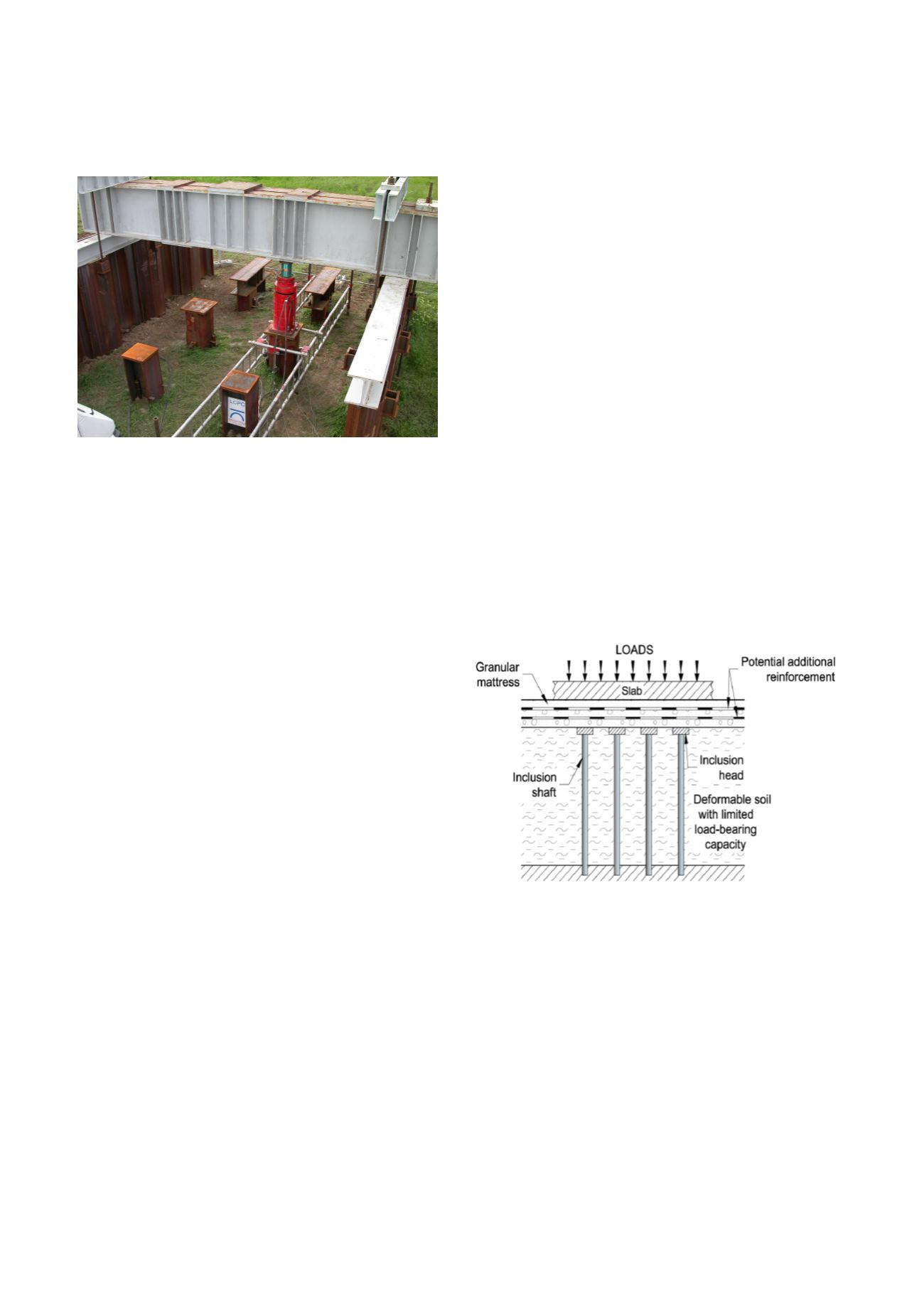

Proceedings of the 18
th
International Conference on Soil Mechanics and Geotechnical Engineering, Paris 2013, volume 6, 2016
piles, the reduction to be anticipated for lateral friction reaches
30% while for tip strength it climbs to 50%. These
recommendations were used to draft the national Eurocode 7
application standard: Design and justification of deep
foundations (NF-P94-262).
Fig. 14: Static loading reaction device - Merville site
6.4.3
Environmental impact and nuisances encountered
This NP has sought to compare acoustic and vibration nuisances
between vibratory driving and hammering so as to provide
greater insight. Effective knowledge of the acoustic levels and
powers of the pile-driving equipment for use with hammering
and vibration is necessary to mitigate this nuisance and divert
most of the attention away from the jobsite. The bibliographical
study and analysis of 5 pile-driving sites concluded that the
acoustic power characterizing site equipment exceeds 5 to 20
dB(A) for both ram weight hammers and pneumatic hammers, as
opposed to vibrators.
Pile driving by reliance on vibrations and hammering causes
waves in the soil. A regulatory study was carried out by
comparing 14 rules, in demonstrating some marked disparities.
The regulation frequency bandwidth for vibratory nuisances lies
between 1 and 100 Hz; moreover, it imposes particle velocities
ranging from 1 to 100 mm/s. In general, the national standards
contain three distinct threshold ranges depending on the type of
structures exposed to vibrations. It can be concluded that among
the threshold levels imposed by the various European standards,
the French ones have a greater built-in safety margin than the
average of all standards evaluated.
In an attempt to better understand this phenomenon of on-site
vibration propagation, a 2D finite element model was built using
the CESAR-LCPC software in a linear dynamic regime. An
axisymmetric model was selected, and 2 pairs of AU 16 piles
driven by vibration were studied. On the whole, the model
yielded satisfactory results for shallow penetrations, which do
represent the majority of foundation works in urban areas. Yet
uncertainties and calibrations remain part of the numerical
model, thus requiring the introduction of a damping coefficient
(using Rayleigh's formulation) in order to approximate reality. It
is regrettable that experimental measurements more than 15 m
from the source have not been included.
6.5
Extensions and outlook
Further research work on this NP is ongoing at: the LCPC
(France), the Construction Industry Scientific and Technical
Center (Belgium), and the College of Science, Technology and
Communication (Luxembourg). Such efforts in the past have
resulted in future publications of doctoral theses, including the
following:
- Hanus V. (2010), Analysis and modelling of noise
generation during vibratory pile driving and determination of the
optimization potential, University of Luxembourg.
- Rocher-Lacoste F. (2008), Full-scale experimental study
and numerical study of vibratory-driven piles: Environmental
vibrations and load-bearing capacity, ENPC, France.
- Whenham V. (2011), A study of energy transfers during
vibratory pile driving, Catholic University of Louvain & CSTC,
Belgium.
In looking forward, besides organizing a new Transvib
symposium, expectations turn to: more widespread on-site
instrumentation; the systematic use of interpretation methods
devised specifically for this NP; and pursuit of a testing program
conducted in the calibration chamber, in conjunction with the
BRAXUUS application (considered well adapted to modeling
purposes). Full-scale tests using a specially instrumented micro-
pile would also prove most beneficial on jobsites, in order to
draw practical lessons, all for a reasonable level of investment
targeting applied research.
7
THE “
ASIRI”
NATIONAL PROJECT ON REINFORCING
FOUNDATION SOILS BY RIGID INCLUSIONS
7.1
Objectives and organization
The concept of foundations in a soil reinforced by rigid
inclusions associates relatively non-deformable vertical elements
with a spread footings or slab-on-grade via a mattress (also
called a distribution layer), often of a granular nature, yet
without any rigid mechanical connection existing between them.
Figure 10 shows the composition of such a foundation on rigid
inclusions.
Fig. 15: Foundation built on rigid inclusions
This technique allows considerably reducing foundation
block settlements under the applied loads while improving block
stability. After being successfully used in Scandinavia, the
United Kingdom and Germany primarily for embankments (built
on piles) in compressible soil zones, the rigid inclusion
technique became widely popular, especially in France, with
original applications to structures containing large surface areas
such as industrial slabs. The field of application is very broad,
spanning simple structures all the way to exceptional facilities
like foundations on the Rion-Antirion Bridge in Greece.
The objectives behind this ASIRI Project were, by virtue of a
diverse array of experimental research projects and their
corresponding numerical analysis methods, as follows:
Volume 6 - Page 86









